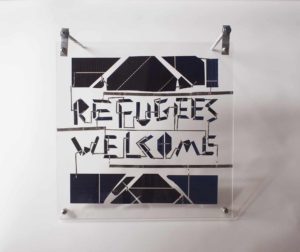Pioneer Works holds workshop to educate artists on science of solar panels
By Diehl Edwards

Accomplished multimedia artist, A/V engineer, curator, and educator, Alex Nathanson, led an interactive workshop at Pioneer Works on the use of solar power in art projects on one hot yet stormy Saturday in August. Most attendants had little to no experience working with solar panels, but were curious just how their projects could benefit from the technology. A sound technician wanted to see how solar power could run his amplifiers. One designer aimed to make solar powered light fixtures. One artist planned to create an outdoor art installation.
The solar panels themselves were odds and ends sourced from large scale manufacturers. They worked with bags of fragments, odd-shaped and brittle dark blue chips of solar panels that didn’t make the cut for satellite use. The panels were made of silicone, a common photovoltaic material, the substance that is conducive for turning visible light into direct current energy (or DC, as Nathanson explained).
Nathanson covered the ins and outs of the science of capturing and transmitting solar energy as the workshop began. Those principles were important to understand, he explained, although not necessary to unpack entirely in order to work with solar panels.
In an introductory exercise, the workshop put together a small-scale solar electric system. They used multi-meters and solder to attach and connect the panels to the motors.
Solar art has held a long appeal. Solar has been applied in many settings, from cost-saving uses by large institutions such as schools, to trendy installations by large corporations, to charged political statements.
“Solar power is inherently political,” Nathanson says, “In many instances it’s a political statement in and of itself. I would definitely stress that in the current atmosphere of climate change denial and federal inaction any investigation or use of alternative energy is political.”

Nathanson was the first to call out sensationalized solar projects that didn’t necessarily live up to their self-promoted hype. Although he didn’t name names, he recognized that because of common misinterpretations about the science and technology surrounding solar energy, some patrons often have skewed expectations of what they’ll get.
The problem is that the explosion of the solar market hasn’t had an accompanying boost in knowledge about the materials. It has been Nathanson’s project to lead these educational seminars to correct that. The reality of solar technology is that it is as variable as the weather and just as precarious.
“It doesn’t always work out,” he said, “but in the context of a work of art, that’s might just be part of it. Sometimes, that’s how life is.”
As far as life imitating art, the day turned out to be an ironic example; it rained steadily though the afternoon. At one point a thunderclap filled the room, a reminder of other natural energy sources humans have wanted to harness (a la Benjamin Franklin and his fabled key on a kite). Yet, despite the cloud cover, Alex was able to get one of his palm-sized prototypes, a three-paneled sculpture with an electric noise maker, to emit its ringing sound.
One of the participants pulled a bright LED flashlight from her bag and that too was able to power the small interactive sculpture. The sun, Nathanson explained, was not the only light source that could activate solar panels, although it was the best one. Any light could be used, and with the implementation of auxiliary tools such as mirrors, the energy source could be amplified.
One thing that attracted attendees to the workshop was the potential of making art that could move, make sound, or light up without having to be plugged into the city’s electrical grid. Solar energy raises the question of what is power, where is it coming from, and what it can be.
Environmental damage and international war contribute much of the electrical energy that powers the country. To be able to draw power directly from the sun detaches a work of art from implication of being a contributor to the very issues it may be a statement against.
By the end of the class, 12 students had assembled their own moving or ringing sculpture, and added a valuable tool to their skillset. As the rain let up, the smaller creations only requiring a single volt to power were able to be run by holding them up to the window and the overcast sky behind it. The larger ones, including a USB charger, would have to wait for brighter days, but those, of course, were just around the corner.
Check out pioneerworks.org/classes for a full list of classes offered at Pioneer Works, including Alex Nathanson’s Solar Power Art Class
Author
-

Diehl Edwards is a writer living in Red Hook, currently working on a memoir about his childhood in Appalachia.
View all posts
Diehl Edwards is a writer living in Red Hook, currently working on a memoir about his childhood in Appalachia.












